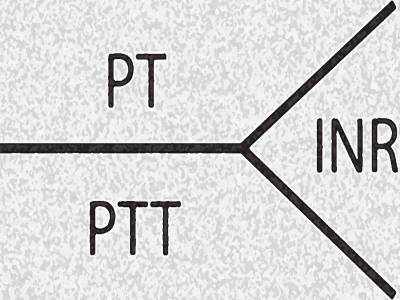Activated Partial Thromboplastin Time (APTT), Partial Thromboplastin Time (PTT), Prothrombin Time (PT) and INR

Why are these tests performed?
- These tests are performed for the diagnosis of bleeding disorders.
- APTT is performed to distinguished the functionality of the clotting factors I, II, V, VII, IX, X, XI, and XII.
- APTT is used to check the treatment of the patient taking heparin or other medicine for blood thinning.
See: Role of laboratory tests is bleeding disorders
Collection of Sample
Venous blood sample is collected from antecubital fossa in a test tube containing trisodium citrate (3.2%), with the anticoagulant to blood proportion being 1:9. See also: Prothrombin time (PT): Collection of Specimen.
Precautions
- Sample handling is very sensitive, false and raised values are obtained if the ratio of blood and anticoagulant is not correct.
- Plasma is stable for one hour if kept at 4º C.
- Plasma can be preserved for 28 days if frozen.
Principles
Activated Partial Thromboplastin Time (APTT)
Plasma is incubated with an activator (which initiates intrinsic pathway of coagulation by contact activation). Phospholipid (also called as partial thromboplastin) and calcium are then added and clotting time is measured.
Partial Thromboplastin Time (PTT)
It is one stage test. It distinguishes the functionality of the clotting factors I, II, V, VIII, X, XI, and XII. Both Activated Partial Thromboplastin Time (APTT) and Partial Thromboplastin Time (PTT) have the same clinical significance but Activated Partial Thromboplastin Time (APTT) is more reliable as compare to Partial Thromboplastin Time (PTT) due to its sensitivity.
Prothrombin Time (PT)
Tissue thromboplastin and calcium are added to plasma and clotting time is determined. The test determines the overall efficiency of extrinsic and common pathways.
International Sensitivity Index (ISI) and International Normalized Ratio (INR)
International Sensitivity Index (ISI) of a particular tissue thromboplastin is derived (by its manufacturer) by comparing it with a reference thromboplastin of known ISI. For standardization and to obtain comparable results, it is recommended to report PT (in persons on oral anticoagulants) in the form of an International Normalized Ratio (INR).
International Normalized Ratio (INR) is calculated by the following formula.
Purpose of INR: The INR is calculated to evaluate the following conditions.
- Atrial fibrillation
- Thrombophilia
- Cardiomyopathy
- Prosthesis (Replacement of heart valve)
- Venous thromboembolism
- Antiphospholipid syndrome
Normal Values
Technique of APTT, PTT, and PT is different in different laboratories therefore normal values varies with the lab to lab. A normal control is always run with the patient's sample. In general, normal values are below.
- APTT: 30-40 seconds
- PTT: 60-70 seconds
- PT: 11-16 seconds
- INR: 1-1.5
| Disease | Required INR Value |
| Deep vein thrombosis prophylaxis | 1.5 to 2.0 |
| Deep vein thrombosis | 2.0 to 3.0 |
| Atrial fibrillation | 2.0 to 3.0 |
| Orthopedic surgery | 2.0 to 3.0 |
| Pulmonary embolism | 2.5 to 3.5 |
| Prosthetic valve prophylaxis | 3.0 to 4.0 |
Critical Values
- APTT: > 70 seconds (Usually it is considered as panic value. If APTT is greater then 100 seconds, spontaneous bleeding may occur.)
- INR: > 5.0 (In Deep Vein Thrombosis (DVT) patient on warfarin treatment, an expected value of INR is between 2.0 to 3.0.)
Reasons for the high results
- Disseminated intravascular coagulopathy (DIC )
- Factor XII deficiency
- Cirrhosis
- Hemophilia A and B
- Von Willebrand’s disease
- Hypofibrinogenemia
- Vitamin K deficiency
- Malabsorption
- Leukemia
- Fibrin breakdown products
- All congenital deficiencies of Intrinsic system coagulation factors
- Drugs
The significance of APTT, PTT, PT, and INR test for the layman
- Patients, taking medication for blood thinning or on heparin treatment, are advised for these laboratory investigations.
- Comment
- Posted by Dayyal Dg.